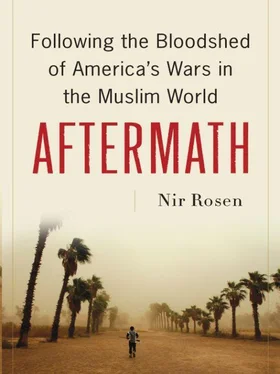I asked a Kurdish Iraqi friend how he felt after seeing the video of Saddam’s execution. “It is sad to see someone who knows he is going to die in a minute,” he told me, “but I am happy that he died that way and not, as the so-called human rights groups want, to be in a jail where they want to make sure he has access to TV, newspaper, and good health.” He agreed with me that the images of Saddam could potentially cause some people to sympathize with him but added, “If anyone who could live the life of an Iraqi for only one day—they would want worse than that to happen to Saddam. Last night, all of a sudden I remembered all the agonies my family went through in their life. We had to leave our home twenty times and walk to the borders and leave everything we had and buy new stuff every few years. He never had the feeling you and I have now for him when he was ordering Ali Hassan Majid and the henchmen to bury people with their kids in the deserts, so why should I now feel sorry for him? But I hope I see one day when the current Saddamlets are hanged too, like Talabani, Ayad Allawi.”
One thing was clear: the death of Saddam did not bring closure or peace to Iraq. Sunnis gathered at Saddam’s grave, demonstrators showed his iconic image, and revenge was threatened. President George Bush declared his nemesis’s death “a milestone.” To many in Iraq and the Muslim world, it was a clear message that there would be no mercy for Sunnis in a Shiite-dominated Iraq.
Part Two

THE IRAQIFICATION OF THE MIDDLE EAST
CHAPTER FOUR
Among the Jihadis
REMARKABLY, THERE WERE NO ATTEMPTS TO ATTACK THE UNITED States in retaliation for its occupation of Iraq, not by American Muslims or by foreigners. But the jihad in Iraq did lead to a regional blowback, and its neighbor Jordan was the first to suffer.
On February 16, 2006, Mohammad Zaki Amawi, Marwan Othman El-Hindi, and Wassim I. Mazloum were indicted by a U.S. district court in Ohio. The three were accused of conspiring to wage jihad against U.S. forces in Iraq, training in firearms and martial arts, collecting funds to support their mission, studying jihad training manuals on the Internet, meeting to plan how best to assist the Iraqi insurgency, studying how to build IEDs, and threatening the life of President Bush. Amawi flew to Jordan in August 2005 carrying laptops he wanted to donate to the mujahideen in Iraq. The indictment added that Amawi “unsuccessfully attempted to enter Iraq to wage violent Jihad, or ‘holy war,’ against the United States and coalition forces.”
Amawi and El-Hindi were Jordanian-born naturalized citizens of the United States. Mazloum was from Lebanon. It was the first time such charges had been made against U.S. residents, but the charges were very similar to ones in numerous court cases in Jordan since the beginning of the Iraq War. These trials were held in the Marka military court, a squat white building across the road from a military airbase that is planted atop a hill in eastern Amman, the somnolent capital of the Hashemite Kingdom of Jordan. Apart from dealing with wayward soldiers, the court also handles security and terrorism cases. Relatives of prisoners stand on line on the curb outside, most dressed in traditional gowns, deep lines on their unshaven faces, waiting to be searched and allowed in. The winter winds blow hard on Amman’s hilltops and muffle the approaching sirens of a police sedan, which is followed by a dark blue van, windowless except for some bars on the back that show only blackness inside. The van is always followed by a pickup truck, with two masked counterterror agents manning a heavy mounted gun on the bed.
On Wednesday, December 28, 2005, the van entered Marka through the main gate and circled around the back of the courthouse. Ten shackled prisoners were taken out and led into a cage in the courtroom. Their lawyers chatted jovially in a smoke-filled waiting room; then made their way past the numerous police officers, security officers, and soldiers bustling back and forth in search of something to do; and headed into the small courtroom, lit with bright fluorescent lights, lined with old wooden benches, and full of blue uniformed Amn al-Am, or General Security, officers.
Muhamad Ibrahim al-Ghawi, twenty-five years old; Faris Sayid Hassan Shoter, thirty-two; Muhamad Jamil al-Titi, twenty-two; Rauf Aballah Abu Mayha, twenty-two; Muhamad Mahmud al-Sharman, twenty-nine; Basil Muhamad al-Ramah, twenty-nine; Monaem Ibrahim Hasan, thirty-one; Raed Ahmed Kaywan, thirty-three; Muhamad Qasim Sulaiman Ramah, thirty-five; and Majdi Khalid Hassan al-Fawar, twenty-one: all stood in the cage, chatting in good spirits, smiling and waving at the few relatives who sat in the back. The cage had a chain-link fence around it, an innovation imposed after one prisoner called Azmi al-Jayusi, a friend of Jordanian terrorist leader Abu Musab al-Zarqawi, threw his shoe at the judge while on trial for attempting to bomb the Jordanian security headquarters. Other prisoners had been known to sing songs in honor of Zarqawi during trial.
All ten prisoners in the cage wore dark blue denim prison suits, wool caps, and slippers. Their beards were shaggy, as was their hair, which curled out of their caps over their ears and the backs of their necks. They were hard to distinguish from one another. Some had a dark stain sunk in above their brows in the center of the forehead. It was a sima, a sign of intense piety, acquired by kneeling and bowing forward, placing the forehead on the floor in prayer. Their long beards and hair were a sign of their beliefs. These men were Salafis.
Salafi ideologues dominated Jordan’s mosques, and young men filled their ranks. Salafism found a home in Jordan beginning in the 1970s, when a Syrian cleric called Muhamad Nasir al-Din Albani began teaching in Jordan at the invitation of the Muslim Brotherhood. Eventually he settled in the Jordanian city of Zarqa to avoid persecution by the secular Syrian Baathists and began preaching about the need to purify Islam. Hundreds came to hear him speak, and he influenced the ranks and hierarchy of Jordan’s clergy. The regime was threatened by the crowds he drew, and he was prohibited from speaking in public. Unable to operate openly, Salafism became an informal underground movement. The late 1970s were a crucial period, as the leftist, secular, and nationalist projects in the Arab world appeared to be failing. Saudi radicals rose up against their regime, temporarily taking the mosque in Mecca; the Soviet Army invaded Afghanistan; and the Iranian Revolution was both a model for political Islamists and a threat to Sunni regimes. By the early 1980s Arab regimes had decided to dispose of their excess radicals by dispatching them to the anti-Soviet jihad in Afghanistan.
Jordan was a ripe environment for political Islam. Since the British invented it in 1924, the kingdom had been ruled by the Hashemites, or Albu Hashem, descendants of the Prophet Muhammad who gained their legitimacy by belonging to Ahl al-Beit, the family of the Prophet. In 1970, when King Hussein fought an uprising of nationalist Palestinians—some of whom promulgated the slogan “The liberation of Jerusalem begins in Amman”—the Muslim Brotherhood, previously disenfranchised, supported King Hussein. The King rewarded them by granting them control over the Ministry of Education, allowing them to inculcate generations of Jordanians. Founded by Egyptian Hassan al-Banna in 1928, it sought to establish a Muslim state through nonviolent cultural revolution.
Radical Islam had received a needed fillip from the Afghan jihad, which began in 1979. But it was following the Gulf War of 1991 that jihadism became an international ideology. The Saudi government’s dependence on the American infidels to protect it from Saddam, and the U.S. presence in the holiest Muslim land, coincided with Muslims’ increasing resentment of their own governments. Arabs who had fought in the Afghan jihad began returning home and were disillusioned with what they encountered, so they sought to bring the jihad home too. The Israeli peace process was but one more betrayal for them. Also following the Gulf War, the Kuwaitis expelled hundreds of thousands of Palestinians, most of whom settled in Jordan. Returning Jordanian jihadis were repelled by the ostentation that accompanied the arrival of wealthy Palestinians to their poor country. One such jihadi was Abu Musab al-Zarqawi, who would lead the Tawhid and Jihad organization of Iraq, later known as Al Qaeda in Iraq. Other Palestinians brought with them a radical jihadist Salafi ideology. Two of them were Abu Muhammad al-Maqdisi, the most important ideologue for modern jihad and Zarqawi’s former mentor, and Abu Anas al-Shami, who went on to become Zarqawi’s key cleric and religious adviser in Iraq. Maqdisi’s writings influenced the jihadis who carried out the 1995 bombings in Saudi Arabia that targeted Americans as well as the September 11 attackers. Zarqawi, Maqdisi, and Shami were heroes for young Jordanians such as those on trial in Marka.
Читать дальше












